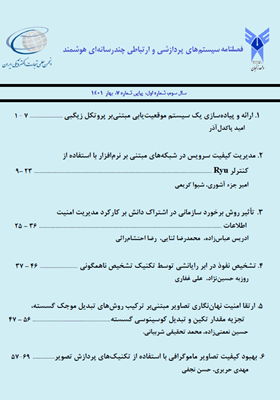مدیریت کیفیت سرویس در شبکههای مبتنی بر نرم افزار با استفاده از کنترلر Ryu
محورهای موضوعی : پردازش چند رسانه ای، سیستمهای ارتباطی، سیستمهای هوشمند
شیوا کریمی
1
*
,
امیر جزء آشوری
2
![]()
1 - استادیار دانشگاه آزاد زنجان، دانشکده برق و کامپیوتر، زنجان، ایران
2 - دانشگاه آزاد زنجان، دانشکده برق و کامپیوتر، زنجان، ایران
کلید واژه: شبکه مبتنی بر نرمافزار, کیفیت سرویس, مدیریت سیاست محور, کنترلر ریو, اوپنفلو, خدمات متمایز, مجازیسازی,
چکیده مقاله :
با ظهور و گسترش تکنولوژیهای مجازیسازی در سالهای اخیر، تعداد سرورها و حجم ترافیک مراکز داده به طرز چشمگیری افزایش یافته است. ازطرف دیگر، رشد و توسعه سرویسها و برنامه های شبکه، موجب افزایش پویایی و غیر قابل پیش بینی شدن الگوهای ترافیک شده و نیازمندی های کیفیت سرویس را افزایش داده است. رویکرد نوین شبکه های مبتنی بر نرم افزار با هدف تسهیل کنترل و مدیریت شبکه و برقراری امکان نوآوری از طریق برنامه نویسی اجزاء شبکه بوجود آمد تا راه حلی امکان پذیر برای مشکلات معماری سنتی ارائه دهد. با جدایی سطوح داده و کنترل، روش های مدیریتی جدیدی ممکن میشود که انعطاف پذیری، کنترل بیشتر و نوآوری مدلهای سرویس را به همراه خواهند داشت. رویکرد ارائه شده در این مقاله، برای اجرای معماری مبتنی بر نرم افزار در توپولوژی یک مرکز داده، استفاده از مدیریت سیاست محور شبکه و روش کیفیت سرویس خدمات متمایز است. چهارچوب ارائه شده، زیر ساختی قابل توسعه در جهت حل چالش مدیریت پویا و چابک در شبکه مراکز داده و ارائه دهندگان خدمات مجازیسازی و پردازش ابری است.
Introduction: Enterprise networks are increasingly becoming larger and more dynamic due to vast deployments of virtualization technologies. Consequently, the explosion of new network applications and services has strained the capabilities of traditional networking architecture in terms of scalability, agility, and efficient traffic management. SDN (Software Defined Networking) is a novel approach to build networks in which control logic is decoupled from data forwarding in order to enable programmability and ease of configuration across the entire network. The centralized control in SDN provides a global view of the entire network resources and their performance which enables the innovation of new service models. This paper demonstrates the implementation of SDN in a sample data center network topology using Mininet and the RYU controller, followed by employing policy-based network management and a differentiated service mechanism for guaranteeing the QoS for different classes of traffic. The proposed framework is a foundation to develop an enterprise-level network control and management product. Method: The approach of this paper is an implementation of a software-based architecture in the topology of a data center. It manages and guarantees the quality of service, using network policy-oriented management and service quality methods. The presented framework is an expandable infrastructure to solve the challenge of dynamic and agile management in the network of data centers and virtualization and cloud processing service providers.Findings : With the implementation done, h1r1 server node listens on ports 5001, 5002, 5003 with UDP protocol. The h1r4 client node sends 1Mbps UDP traffic to port 5001, 300Kbps UDP traffic to port 5002, and 600Kbps UDP traffic to port 5003 of the h1r1 server. The results obtained using the IPerf3/JPerf tool show that for traffic marked with AF41 code sent to port 5003, minimum bandwidth of 500Kbps and for traffic marked with AF31 code sent to port 5002, minimum bandwidth of 200Kbps is guaranteed. Is. When sending traffic of AF classes, the bandwidth of the best-effort traffic sent to port 5001 is limited.Conclusion: Guaranteeing full quality of service for all types of applications is not possible with the current network architecture based on the best-effort model. Different applications have different service needs that require dynamic management of network resources. In this article, a solution based on SDN architecture was presented for service quality management, which uses a differentiated service model. Differentiated service mechanism allocates resources based on different traffic classes. In this method, all streams belonging to a class are routed equally. The results obtained from the simulations show the optimal performance of the introduced framework in meeting the needs of traffic flows and optimal and maximum use of network resources.
_||_

